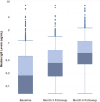Nigeria healthcare worker SARS-CoV-2 serology study: Results from a prospective, longitudinal cohort
- PMID: 36962953
- PMCID: PMC10022168
- DOI: 10.1371/journal.pgph.0000549
Nigeria healthcare worker SARS-CoV-2 serology study: Results from a prospective, longitudinal cohort
Abstract
Healthcare workers, both globally and in Nigeria, have an increased risk for SARS-CoV-2 infection compared with the general population due to higher risk contacts, including occupational exposures. In addition, primary healthcare workers represent an important group for estimating prior infection to SARS-CoV-2 because they work at the first point-of-contact for most patients yet have not been included in prior COVID-19 seroepidemiology research in Nigeria. We sought to evaluate baseline seroprevalence, rates of seroconversion (IgG- to IgG+) and seroreversion (IgG+ to IgG-), change in IgG concentration at 3- and 6-month follow-up, and factors associated with seropositivity. From June 2020 to December 2020, we conducted a longitudinal seroepidemiology study among frontline health care workers in Nigeria using a validated dried blood spot assay. Among 525 participants, mean (SD) age was 39.1 (9.7) years, 61.0% were female, and 45.1% were community health workers. The six-month follow-up rate was 93.5%. Seropositivity rates increased from 31% (95% CI: 27%, 35%) at baseline to 45% (95% CI: 40%, 49%) at 3-month follow-up, and 70% (95% CI: 66%, 74%) at 6-month follow-up. There was a corresponding increase in IgG levels from baseline (median = 0.18 ug/mL) to 3-month (median = 0.35 ug/mL) and 6-month follow-up (median = 0.59 ug/mL, Ptrend < .0001). A minority of participants reported symptoms from February 2020 until baseline (12.2%) or during 3-month (6.6%) or 6-month (7.5%) follow-up. only 1 participant was hospitalized. This study demonstrated high baseline, 3-month and 6-month follow-up prevalence of IgG antibodies to SARS-CoV-2 during the first two waves of the COVID-19 pandemic in Nigeria among a cohort of unvaccinated frontline healthcare workers, including primary healthcare workers despite low symptomatology. These results may have implications in state- and national-level disease pandemic modeling. Trial registration: NCT04158154.
Copyright: © 2023 Ojji et al. This is an open access article distributed under the terms of the Creative Commons Attribution License, which permits unrestricted use, distribution, and reproduction in any medium, provided the original author and source are credited.
Conflict of interest statement
I have read the journal’s policy and one of the authors, MDH has the following competing interests:” has patents pending for combination therapy for the treatment of heart failure (HFpEF Poly diuretic) with application serial number: 63/261,121. The George Institute for Global Health has a patent, license, and has received investment funding with intent to commercialize fixed-dose combination therapy through its social enterprise business, George Medicines. The other authors do not report any disclosures.
Figures


Similar articles
-
Pre-exposure prophylaxis with hydroxychloroquine for high-risk healthcare workers during the COVID-19 pandemic: A structured summary of a study protocol for a multicentre, double-blind randomized controlled trial.Trials. 2020 Jul 29;21(1):688. doi: 10.1186/s13063-020-04621-7. Trials. 2020. PMID: 32727613 Free PMC article.
-
The Seroprevalence and Seropositivity of SARS-CoV-2 among Healthcare Workers during the Third Pandemic Wave.Antibodies (Basel). 2022 Dec 23;12(1):2. doi: 10.3390/antib12010002. Antibodies (Basel). 2022. PMID: 36648886 Free PMC article.
-
Healthcare institutions' recommendation regarding the use of FFP-2 masks and SARS-CoV-2 seropositivity among healthcare workers: a multicenter longitudinal cohort study.Antimicrob Resist Infect Control. 2022 Jan 10;11(1):6. doi: 10.1186/s13756-021-01047-x. Antimicrob Resist Infect Control. 2022. PMID: 35012679 Free PMC article.
-
Half-Year Longitudinal Seroprevalence of SARS-CoV-2-Antibodies and Rule Compliance in German Hospital Employees.Int J Environ Res Public Health. 2021 Oct 19;18(20):10972. doi: 10.3390/ijerph182010972. Int J Environ Res Public Health. 2021. PMID: 34682719 Free PMC article.
-
High seroprevalence of anti-SARS-CoV-2 antibodies among Ethiopian healthcare workers.BMC Infect Dis. 2022 Mar 16;22(1):261. doi: 10.1186/s12879-022-07247-z. BMC Infect Dis. 2022. PMID: 35296265 Free PMC article.
References
-
- Johns Hopkins Coronavirus Resource Center [Internet]. Available from: https://coronavirus.jhu.edu/map.html. Accessed 18 April 2022.
-
- COVID-19 Household Seroprevalence Surveys [Internet]. Available from: https://ncdc.gov.ng/news/323/ncdc-and-nimr-release-findings-of-covid-19-.... Accessed 18 April 2022.
Associated data
Grants and funding
LinkOut - more resources
Full Text Sources
Medical
Miscellaneous
